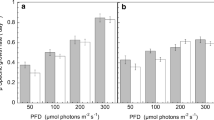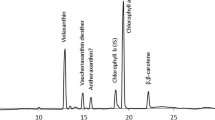Abstract
Pigment composition and its variation with culture agewere analyzed in six strains of Nannochloropsis(Eustigmatophyceae). The capacity for accumulationof the ketocarotenoids astaxanthin and canthaxanthinwas higher in N. salina and N. gaditanathan in the other strains studied here. Theinfluence of salinity (15 to 100 practical units) onpigment production was studied in N. gaditana,where a defined pattern of variation could not befound apart from a notable increase in zeaxanthin at100‰. In cultures grown in a photobioreactor and athigh cell densities of about 109 cells mL-1,pigment production reached: 350 mg L-1 forchlorophyll a, 50 mg L-1 for violaxanthin,5 mg L-1 for canthaxanthin, 3 mg L-1 forastaxanthin. The highest contents of canthaxanthin andastaxanthin obtained in experiments with N.gaditana were 19.4 and 14.6 ng pigment (106cells)-1, respectively, which accounts for 0.7%dry weight. By means of xanthophyll cycle inductionthrough exposure of cells to high irradiance and at40 °C, conversion of violaxanthin intozeaxanthin may attain up to 70% of the violaxanthincontent, which corresponds to 0.6% dry weight. Theresults indicate that interest in Nannochloropsis as a source of valuable pigments isnot related to its capacity for single pigmentaccumulation, but the availability of a range ofpigments such as chlorophyll a, zeaxanthin,canthaxanthin and astaxanthin, each with highproduction levels.
Similar content being viewed by others
References
Andersen RA, Brett RW, Potter D, Sexton JP (1998) Phylogeny of the Eustigmatophyceae based upon 18 rDNA, with emphasis on Nannochloropsis. Protist 149: 61-74.
Antia NJ, Bisalputra T, Cheng JY, Kalley JP (1975) Pigment and cytological evidence for reclassification of Nannochloropsis oculata and Monallantus salina in the Eustigmatophyceae. J. Phycol. 11: 339-343.
Antia NJ, Cheng JY (1982) The keto-carotenoids of two marine coccoid members of the Eustigmatophyceae. Br. phycol. J. 17: 39-50.
Berland BR, Bonin DJ, Daumas RA, Laborde PL, Maestrini SY (1970) Variations du comportement physiologique de l'alge Manallantus salina (Xanthophycée) en culture. Mar. Biol. 7: 82-92.
Borowitzka MA (1992) Comparing carotenogenesis in Dunaliella and Haematococcus: implications for commercial production strategies. In Villa TG, Abalde J (eds), Profiles on Biotechnology. Servicio de Publicaciones. Universidad de Santiago, Spain: pp. 301-310.
Borowitzka MA, Borowitzka LJ, Kessly D (1990) Effects of salinity increase on carotenoid accumulation in the green alga Dunaliella salina. J. appl. Phycol. 2: 111-120.
Chaumont D, Thépeneir C (1995) Carotenoid content in growing cells of Haematococcus pluvialis during a sunlight cycle. J. appl. Phycol. 7: 529-537.
Czygan FC (1968) Sekundär-Carotinoide in Grünalgen. I. Chemie, Vorkommen und Faktoren, Welche die Bildung dieser Polyene beeinflussen. Arch. Mikrobiol. 61: 81-102.
Guillard RRL, Murphy LS, Foss P, Liaaen-Jensen S (1985) Synechococcus spp. a likely zeaxanthin-dominant ultraphytoplankton in the North Atlantic. Limnol. Oceanogr. 30: 412-414.
Harker M, Tsavalos AJ, Young AJ (1995) Use of response surface methodology to optimise carotenogenesis in the microalga, Haematococcus pluvialis. J. appl. Phycol. 7: 399-406.
Karlson B, Potter D, Kuylenstierna M, Andersen RA (1996) Ultrastructure, pigment composition, and 18S rRNA gene sequence for Nannochoropsis granulata sp. nov. (Monopsidaceae, Eustigmatophyceae), a marine ultraplankter isolated from Skagerrak, northeast Atlantic Ocean. Phycologia 35: 253-260.
Lubián LM, Establier R (1982) Comparative study of the pigment composition in several strains of Nannochloropsis (Eustigmatophyceae) during its growth in culture. Inv. Pesq. 46: 379-389.
Lubián LM, Establier R (1983) Quantitative variations of pigments of Nannochloropsis gaditana Lubián, 1983 (Eustigmatophyceae) during its growth in culture. Inv. Pesq. 47: 29-38.
Lubián LM, Establier R, Ruiz E (1986) Light and nitrate influence on the growth and pigment contents of Nannochloropsis gaditana Lubián in culture. Inv. Pesq. 50: 499-518.
Lubián LM, Montero O (1998) Excess light-induced violaxanthin cycle activity in Nannochloropsis gaditana (Eustigmatophyceae): effects of exposure time and temperature. Phycologia 37: 16-23.
Lubián LM, YÚfera M (1989) Colección de cepas de microalgas marinas del Instituto de Ciencias Marinas de Andalucía (CSIC). In YÚfera M (ed.), Acuicultura Intermareal. Consejo Superior de Investigaciones Científicas, Cádiz, Spain: pp. 69-78.
Mantoura RFC, Llewellyn CA (1983) The rapid determination of algal chlorophyll and carotenoid pigments and their breakdown products in natural waters by reverse-phase high-performance liquid chromatography. Analyt. Chim. Acta 151: 297-314.
Owens TG, Gallagher JC, Alberte RS (1987) Photosynthetic light-harvesting function of violaxanthin in Nannochloropsis spp. (Eustigmatophyceae). J. Phycol. 23: 79-85.
Rowan KS (1989) Photosynthetic Pigments of Algae. Cambridge U. P., New York: 334 pp.
Whittle SJ, Casselton PJ (1975) The chloroplast pigments of the algal classes Eustigmatophyceae and Xanthophyceae. I. Eustigmatophyceae. Br. phycol. J. 10: 179-191.
Zlotnik (Shmerler) I, Sukenik A, Dubinsky Z (1993) Physiological and photosynthetic changes during the formation of red aplanospores in the chlorophyte Haematococcus pluvialis. J. Phycol. 29: 463-469.
Author information
Authors and Affiliations
Rights and permissions
About this article
Cite this article
Lubián, L.M., Montero, O., Moreno-Garrido, I. et al. Nannochloropsis (Eustigmatophyceae) as source of commercially valuable pigments. Journal of Applied Phycology 12, 249–255 (2000). https://doi.org/10.1023/A:1008170915932
Issue Date:
DOI: https://doi.org/10.1023/A:1008170915932




